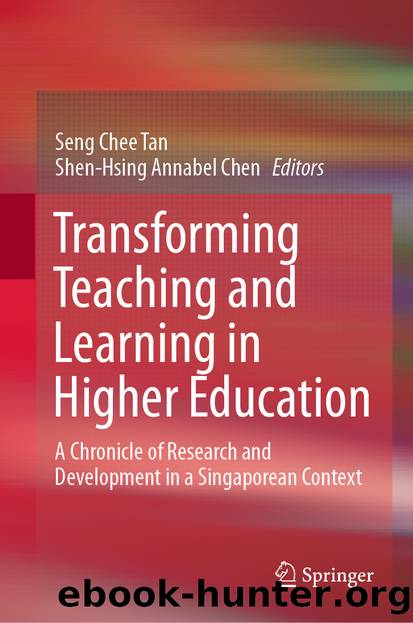Transforming Teaching and Learning in Higher Education by Unknown

Author:Unknown
Language: eng
Format: epub
ISBN: 9789811549809
Publisher: Springer Singapore
6.3.2 Orchestration of Learning
Following the relatively positive success of the midterm exam changes, we sought to restructure the focus and delivery of the remaining lectures and fine-tune the peer review process.
6.3.2.1 Transforming the Orchestration of Lectures
After establishing the rules for generating well-crafted and balanced midterm items, we moved our transformation efforts to the next most obvious issue—the inverse relationship between student attendance and the week of the semester. Each week, fewer students attended the lecture than the week before. We could see it in the unfilled seats in the auditorium and the dwindling participation rates for the clicker questions.
From talking to students, we knew and could empathize with the reasons. As a semester progresses, students are under more obligations from more sources and they rebalance their time accordingly. Some instructors rationalize the decline as a character flaw common in students. Other instructors actively fight against the trend by mandating attendance or incorporating weekly quizzes that require students to show up each week. By making structural changes, these instructors can continue delivering lectures to a roomful of students. However, tactics that incentivize students to appear in class make it difficult to make claims about self-directed learners and intrinsic motivation.
From the front of the class, there is a difference between teaching a half-filled seminar and a half-filled auditorium. In the seminar case, the instructor can strategically place students around the discussion table to create a sense of intimacy. Working with a half-filled, or quarter-filled auditorium is different. Students predictably disperse themselves in small clusters throughout the auditorium. Those clusters are then difficult to consolidate into one region of the auditorium. For the second part of the semester, we worked under the hypothesis that if we transformed the lectures into sequences of interestingly packaged content interspersed with engaging discussion questions, we could at least stem the drop-off in attendance between each week’s lecture.
In Year 1, the pace of a week’s lecture followed a predictable pattern. The instructor would spend 5–10 min on a topic and ask a clicker question that measured the students’ comprehension of what was just explained. During the final 15–20 min of the lecture period, the instructor would release a set of small group discussion questions. Students would assemble into groups and discuss among themselves or the teaching team. As the weeks went on, the time between the clicker questions increased and the participation at the end of class discussion questions decreased.
As we discussed how to transform the orchestration of the lectures, we realized that we had two different notions of what was important for delivering a “good” lecture. From a domain expert’s standpoint, introducing students to facts and definitions that they can later apply was essential to a good lecture. From a preparation for future learning standpoint, introducing students to activities designed to help them reason through complex issues in the future was the most important element (Bransford and Schwartz, 1999). Because we were operating from different starting points, as many multidisciplinary teams do, the ease with which we transformed the midterm items did not translate to reworking the lecture content.
Download
This site does not store any files on its server. We only index and link to content provided by other sites. Please contact the content providers to delete copyright contents if any and email us, we'll remove relevant links or contents immediately.
The Five People You Meet in Heaven by Mitch Albom(3520)
The Secret Power of Speaking God's Word by Joyce Meyer(3067)
Real Sex by Lauren F. Winner(2986)
Name Book, The: Over 10,000 Names--Their Meanings, Origins, and Spiritual Significance by Astoria Dorothy(2960)
The Holy Spirit by Billy Graham(2914)
0041152001443424520 .pdf by Unknown(2812)
How The Mind Works by Steven Pinker(2776)
ESV Study Bible by Crossway(2758)
Ancient Worlds by Michael Scott(2650)
Churchill by Paul Johnson(2543)
The Meaning of the Library by unknow(2533)
The ESV Study Bible by Crossway Bibles(2528)
The Gnostic Gospels by Pagels Elaine(2496)
MOSES THE EGYPTIAN by Jan Assmann(2395)
Jesus by Paul Johnson(2330)
City of Stairs by Robert Jackson Bennett(2328)
The Complete Dead Sea Scrolls in English (7th Edition) (Penguin Classics) by Geza Vermes(2258)
Ancient Near Eastern Thought and the Old Testament by John H. Walton(2205)
The Nativity by Geza Vermes(2202)
